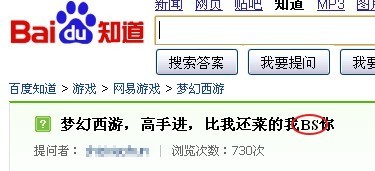A handy guide to Pinyin acronyms
First of all, let’s have a quick tutorial on some commonly used Pinyin acronyms.
SF

沙發Sa1 Fa1. Literally, it means a sofa. Metaphorically, it means the first person who replied a thread
e.g. 太好了!我終於搶到SF了!
Great! Finally I grab the chance to reply first!
-------------------------------
BS

鄙視 Bi3 Shi4. To look down on somebody.
e.g. 我BS你這種人了!
I look down on people like you!
-------------------------------
TX

同學 Tong2 Xue2. Literally, it means classmate. On the Internet, it is used to represent fellow or friend when you want to address somebody.
e.g. 有沒有TX可以告訴我誰是陳偉霆呀?
Can any fellow tell me who William Chan is?
-------------------------------
LZ

樓主 Lou2 Zhu3. Thread starter.
e.g. LZ說得對!
Thread starter, you’re right!
-------------------------------

待見 Dai4 Jian4. To like someone.
e.g. 我不dj我姊男友!
I don't like my elder sister's boyfriend!
Why do Mainland netizens use Pinyin acronyms so often?
1. Influence of Pinyin Input System

Most Mainlanders use Pinyin Input System to type in words. Usually, there is no need to input the Pinyin of the whole character. You just need to type the first letter of each character of the word and the word will pop up from the Input System. As people are used to Pinyin Input System, they bring the Pinyin acronyms into their Internet threads or text messages.
2. Euphemism
Some words are vulgar or foul language, therefore Pinyin acronyms are used instead as euphemism, in order to neutralize the tone or make it less provocative at a first glance. For example, TMD is usually used instead of 他媽的(foul language). People used NB sometimes to replace 牛屄(foul language in Northern dialect).
3. The Nature of Netspeak as a written speech
As Hale and Scanlon[1] suggested, Netspeak is a type of communication that "write the way people talk". Futhermore, Crystal [2] said, "what makes Netspeak so interesting, as a form of communica- tion, is the way it relies on characteristics belonging to both sides of the speech/writing divide." Pinyin acronyms require reader to spell the word out to guess what they stand for, making the text more conversational.
4. To avoid censorship
This will be further discussed here.
[1] Wired style: principles of English usage in the digital age (Hale and Scanlon, 1999)
[2] Language and the Internet (Crystal,2006)
Further readings:
1. Internet language and Netspeak (Chun,2003)
2. Guidebook to Chinese Internet Slangs
No comments:
Post a Comment